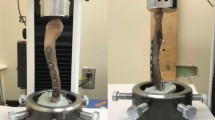Abstract
Objectives
Operative fixation of displaced mid-shaft clavicle fractures has been shown to improve the functional outcomes and decrease the likelihood of non-union; however, little is known about the need for locking screws versus traditional screws. We, therefore, evaluated the strength of unicortical locked plating versus traditional bicortical non-locking fixation methods.
Methods
Ten matched pairs of fresh, frozen cadaver clavicle specimens were obliquely osteotomized through the mid-shaft to represent the most common fracture pattern. After randomization, the clavicles were repaired using pre-contoured plates with either standard bicortical non-locking screws or unicortical locking screws. The constructs were then potted in cement and tested on a MTS machine using a custom gimble and evaluated for load to failure and axial and rotational stiffness.
Results
There was no significant difference between the constructs in terms of axial stiffness (locking 688.3 ± 306.2 N/mm, non-locking 674.5 ± 613.0 N/mm; p = 0.77) or load to failure (locking 720.1 ± 232.0 N, non-locking 664.8 ± 167.5 N; p = 0.46). However, rotational stiffness varied significantly (locking 1.70 ± 0.91 N-m/mm, non-locking 2.49 ± 0.78 N-m/mm, p = 0.049) with bicortical non-locking constructs exhibiting higher torque values.
Conclusions
Unicortical fixation using pre-contoured plates and locking screws has a similar biomechanical profile compared to gold standard non-locked bicortical screws in cyclic axial compression and axial load to failure. Non-locking constructs were stiffer under rotational testing. This technique may provide a suitable biomechanical environment for bony healing. This may also improve the safety of clavicle plating by protecting infraclavicular structures from injury during drilling or screw penetration as it obviates the need for bicortical fixation.




Similar content being viewed by others
References
Zlowodzki M, Zelle BA, Cole PA et al (2005) Treatment of acute midshaft clavicle fractures: systematic review of 2144 fractures: on behalf of the Evidence-Based Orthopaedic Trauma Working Group. J Orthop Trauma 19(7):504–507
Celestre P, Roberston C, Mahar A et al (2008) Biomechanical evaluation of clavicle fracture plating techniques: does a locking plate provide improved stability? J Orthop Trauma 22(4):241–247
Nordqvist A, Petersson C (1994) The incidence of fractures of the clavicle. Clin Orthop Relat Res 300:127–132
Bernstein J (2007) Nonoperative treatment compared with plate fixation of displaced midshaft clavicular fractures. J Bone Joint Surg Am 89(8):1866–1867
Hill JM, McGuire MH, Crosby LA (1997) Closed treatment of displaced middle-third fractures of the clavicle gives poor results. J Bone Joint Surg Br 79(4):537–539
Nordqvist A, Petersson CJ, Redlund-Johnell I (1998) Mid-clavicle fractures in adults: end result study after conservative treatment. J Orthop Trauma 12(8):572–576
Nowak J, Holgersson M, Larsson S (2005) Sequelae from clavicular fractures are common: a prospective study of 222 patients. Acta Orthop 76(4):496–502
Johnson B, Thursby P (1996) Subclavian artery injury caused by a screw in a clavicular compression plate. Cardiovasc Surg 4(3):414–415
Shackford SR, Connolly JF (2003) Taming of the screw: a case report and literature review of limb-threatening complications after plate osteosynthesis of a clavicular nonunion. J Trauma 55(5):840–843
Regel JP, Pospiech J, Aalders TA et al (2002) Intraspinal migration of a Kirschner wire 3 months after clavicular fracture fixation. Neurosurg Rev 25(1):110–112
Azimi M, Adipepe F, Haykal S et al (1990) Recurrent pneumothorax after osteosynthesis of the clavicle. Apropos of a case. J Chir (Paris) 127(6):365
Marchi E, Reis MP, Carvalho MV (2008) Transmediastinal migration of Kirschner wire. Interact Cardiovasc Thorac Surg 7(5):869–870
Iannotti MR, Crosby LA, Stafford P et al (2002) Effects of plate location and selection on the stability of midshaft clavicle osteotomies: a biomechanical study. J Shoulder Elbow Surg 11(5):457–462
Kemper A, Stitzel J, Gabler C et al (2006) Biomechanical response of the human clavicle subjected to dynamic bending. Biomed Sci Instrum 42:231–236
Bostman O, Manninen M, Pihlajamaki H (1997) Complications of plate fixation in fresh displaced midclavicular fractures. J Trauma 43(5):778–783
Der Tavitian J, Davison JN, Dias JJ (2002) Clavicular fracture non-union surgical outcome and complications. Injury 33(2):135–143
Roberts JW, Grindel SI, Rebholz B et al (2007) Biomechanical evaluation of locking plate radial shaft fixation: unicortical locking fixation versus mixed bicortical and unicortical fixation in a sawbone model. J Hand Surg (Am) 32(7):971–975
Gardner MJ, Brophy RH, Campbell D et al (2005) The mechanical behavior of locking compression plates compared with dynamic compression plates in a cadaver radius model. J Orthop Trauma 19(9):597–603
Wu CC, Shih CH, Chen WJ et al (1998) Treatment of clavicular aseptic nonunion: comparison of plating and intramedullary nailing techniques. J Trauma 45(3):512–516
Lee YS, Lin CC, Huang CR et al (2007) Operative treatment of midclavicular fractures in 62 elderly patients: knowles pin versus plate. Orthopedics 30(11):959–964
Khalil A (2009) Intramedullary screw fixation for midshaft fractures of the clavicle. Int Orthop 33(5):1421–1424
Mueller M, Rangger C, Striepens N et al (2008) Minimally invasive intramedullary nailing of midshaft clavicular fractures using titanium elastic nails. J Trauma 64(6):1528–1534
Ruedi TP, Buckley RE, Moran CG (2007) AO principles of fracture management, vol 1, 2nd edn. Thieme, AO publishing, AO Foundation, Switzerland, pp 266–268
Harnroongroj T, Vanadurongwan V (1996) Biomechanical aspects of plating osteosynthesis of transverse clavicular fracture with and without inferior cortical defect. Clin Biomech 11(5):290–294
Robertson C, Celestre P, Mahar A et al (2009) Reconstruction plates for stabilization of mid-shaft clavicle fractures: differences between nonlocked and locked plates in two different positions. J Shoulder Elbow Surg 18(2):204–209
Acknowledgments
The authors acknowledge the support of the Palo Alto Veterans Administration Hospital, Bone & Joint Center of Excellence, R&D Center (Palo Alto, CA). Support granted for specimens and plates by Acumed TM, Hillsboro, OR. The authors have received no financial remuneration for the preparation of this article.
Author information
Authors and Affiliations
Corresponding author
Rights and permissions
About this article
Cite this article
Hamman, D., Lindsey, D. & Dragoo, J. Biomechanical analysis of bicortical versus unicortical locked plating of mid-clavicular fractures. Arch Orthop Trauma Surg 131, 773–778 (2011). https://doi.org/10.1007/s00402-010-1212-2
Received:
Published:
Issue Date:
DOI: https://doi.org/10.1007/s00402-010-1212-2




